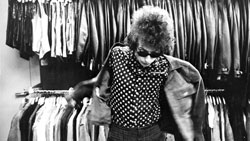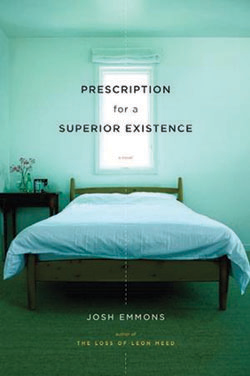Fifty years ago, Bob Dylan released his album Blonde on Blonde, and it’s still just as epic today. So, on Tuesday, Oct. 25, the University’s Record Club celebrated this anniversary and hosted its second album review of the year at 7:30 in Pollak Theatre.
“There’s a lot of artistic risk on this album,” said Kenneth Womack, Ph.D., and Dean of the Department of English. He and two other panelists, Michael Thomas, M.F.A., and Associate Dean/Director of the School of Humanities and Social Sciences, alongside Ronnie Brandt, a “Musician at Large,” gathered to discuss one of Dylan’s greatest successes.
The night began with a brief video of a live performance of Dylan’s “No Direction Home.” The video was from 1966 and showed various English people trashing the new style that Dylan was taking up. Some argued that all of his music was better prior to the new sound of this album and that he was going downhill. However, they seemed to have predicted incorrectly.
The first song that the panelists discussed in this hour-and-a-half-long record review, was “Rainy Day Women #12 & 35.” “This was a big commercial hit, but it took a while to get airplay because radios wouldn’t play it,” said Brown. He continued to say that radios wouldn’t play it likely because it was such a different style than before. “He went from being a successful folk singer to a new sound, but what some people don’t know is that Dylan was a Rock-N-Roll nut before he did folk,” Brown added.
The second song discussed was “Visions of Johanna,” which seemed to capture the audience’s attention. This song seemed to have a slower rhythm than the first, but both contained the classic harmonica sound that Dylan included in most songs on Blonde on Blonde.
“This song was the first one that caught my attention,” said an audience member and alumni of the University, who had just listened to this album for the first time the day before. “It reminded me of contemporary folk music. It’s like a soft acoustic ballad, and it’s serene.”
“He’s inventing Americana in this,” said John Hanly, Ph.D., and Assistant Professor of English, during the discussion. “I have appreciated the opportunity to bring my class to the events because our attending the Tuesday Night Record Club meetings together had given them the opportunity to see a wide range of others – invited panelists, faculty, administrators, students, and interested community members – who are similarly invested in thinking critically about, discussing, and debating the cultural and aesthetic value of the popular music they listen to.”
The third song discussed of the night was “One of Us Know (Sooner or Later),” which was probably my favorite song of the night. Thomas introduced this song by showing Dylan’s first take of the song in the studio, which showed a bit about his personality. I liked being able to hear Dylan work through what needed to happen in this song, such as when he expressed that he was unsure if he should play the piano in it or not. It felt as though I was actually there for the creative process and showed how Dylan worked through this song in his head.
After we listened to the first take, Thomas played the finalized version that made the album. Here, we were able to hear the transition ourselves and see how Dylan worked through the song, which may be why I enjoyed this one the most. As Thomas said during the discussion, it really showed how you have to work through the bad to get the good.
The fourth song discussed, ironically, was “4th Time Around.” The 4 minute and 38-second-long song, was “Bob Dylan impersonating Bob Dylan,” Brown jokingly added.
Thomas pointed out that this song really seemed to show Dylan’s soft side. One stanza in the song says, “She threw me outside, I stood in the dirt where everyone walked, and after finding I’d forgotten my shirt, I went back and knocked. I waited in the hallway, she went to get it and I tried to make sense out of that picture of you in your wheelchair,” which Thomas said stood out to him.
After playing this line for us, Thomas added that this song illustrated Dylan’s fun side at the same time, such as when Dylan says “I said, ‘Your words aren’t clear, you’d better spit out your gum.’”
The most interesting part of this song’s discussion seemed to be the relation to John Lennon. Prior to this event, I had no idea that Lennon and Dylan had a weird rivalry dynamic. Dylan admired Lennon, but the late Beatles member had a dislike for Dylan, which is rumored to have roots with Dylan’s release of this song. Whether this is true or not is debated.
The last song discussed was “Just Like a Woman.” Thomas played the regular version of this song and then compared it with the acoustic version, which I appreciated. Dylan showed much more emotion in his voice in the acoustic version and the comparison of the editions seemed to show two different sides to the musician, though they were the same lyrics.
In reference to the change-up, Thomas said, “It’s very common for Dylan to record a song one way and then perform it another.” He also added, “If we go along with his changeability, we can keep falling in love with the music.”
This is why we can still enjoy Bob Dylan’s music. The messages are timeless and, according to Thomas, there are layers to the music that he produces. “He captures an American sound, the essence of the 1960s, and he’s part of our musical heritage,” Thomas said. “I think he’s a poet. He can ask questions and create imagery in his lyrics the way poets do.”
I particularly enjoyed this Record Club review because contrary to the previous, the audience had more of a say in which songs were reviewed. This time, the panelists would ask the audience which songs they’d like to talk about, which promoted more of a discussion and less of a lecture.
Thomas agreed that the event was a success, saying, “I loved the range of age, experience, and knowledge in the audience. This was my first time experiencing Record Club, and it really gets everyone to come together.”
The next album review will be on Blondie’s Parallel Lines, and will take place next semester on Feb. 7 at 7:30 in Woods Theatre.
IMAGE TAKEN from Rolling Stone



